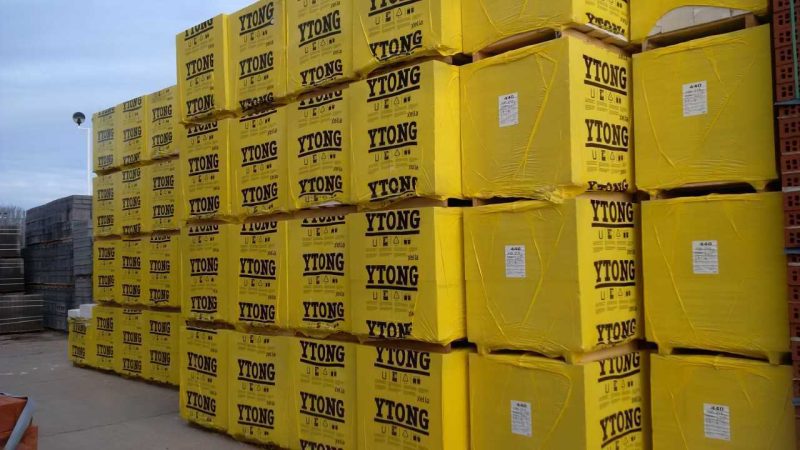In recent years, sustainable building practices have gained significant traction as the construction industry seeks to reduce its environmental impact. Among the various materials available, Ytong block has emerged as a leading choice for eco-friendly construction. Made from autoclaved aerated concrete (AAC), it offers a unique combination of thermal insulation, lightweight properties, and energy efficiency. This article explores 10 compelling reasons why Ytong block is the ultimate choice for eco-friendly building, making it a preferred option for builders, architects, and environmentally conscious homeowners.
Ytong Block Offers Exceptional Thermal Insulation
One of the standout features of Ytong block is its exceptional thermal insulation properties. The unique structure of autoclaved aerated concrete provides excellent insulation, significantly reducing heat loss in winter and keeping buildings cool in summer. This results in lower energy consumption for heating and cooling, making homes constructed with Ytong blocks more energy-efficient. Consequently, homeowners can enjoy reduced energy bills while minimising their carbon footprint.
Ytong Block is Lightweight and Easy to Handle
Ytong block is remarkably lightweight compared to traditional building materials like concrete or bricks. This feature makes it easier to transport and handle on-site, reducing labour costs and speeding up the construction process. The lightweight nature of Ytong block also means less strain on structural components, leading to a more efficient use of resources. Builders appreciate the convenience of working with this material, which translates to quicker project completion times.
Environmentally Friendly Production of Ytong Block
The production process of Ytong block is inherently eco-friendly. Made from natural raw materials like sand, cement, lime, and water, the manufacturing of Ytong blocks produces minimal waste. Furthermore, the energy used in the production process is significantly lower than that of traditional concrete blocks, contributing to a smaller carbon footprint. By choosing Ytong block, builders can align their projects with sustainable practices from the very start.
Excellent Fire Resistance of Ytong Block
Fire safety is a critical concern in construction, and Ytong block excels in this area. Made from inorganic materials, these blocks are highly fire-resistant and do not contribute to the spread of flames. This characteristic provides additional safety for occupants and can reduce insurance costs for homeowners. Buildings constructed with Ytong blocks can withstand high temperatures, making them a reliable choice for fire-prone areas.
Benefits of Using Lightweight Building Materials
Lightweight building materials offer numerous advantages in construction. They simplify the transportation and handling process, making it easier for construction teams to manage and install materials on-site. Additionally, lightweight options can reduce the overall weight of a structure, which may lead to lower foundation costs and less structural reinforcement needed. These materials also contribute to quicker project completion times, as they require less labour and can be manoeuvred easily. By using lightweight building materials, builders can enhance efficiency while minimising the environmental impact of their projects.
Understanding Autoclaved Aerated Concrete (AAC)
Autoclaved Aerated Concrete (AAC) is a revolutionary building material known for its unique properties and environmental benefits. Created through a process that involves mixing raw materials like sand, cement, lime, and water with a small amount of aluminium powder, AAC expands and hardens under high pressure and temperature in an autoclave. This process creates a lightweight, porous material that provides excellent insulation, fire resistance, and soundproofing capabilities. Understanding the benefits and applications of AAC is crucial for builders and architects looking to incorporate sustainable practices into their designs.
Fire Safety in Modern Construction
Fire safety is a critical aspect of modern construction, as it directly impacts the safety and well-being of building occupants. Advances in building materials, such as those that offer fire-resistant properties, have become increasingly important in reducing the risk of fire spread. Materials like autoclaved aerated concrete (AAC) provide exceptional fire resistance due to their inorganic composition. Implementing fire safety measures in building design and material selection helps to protect lives, reduce property damage, and meet regulatory standards, ultimately contributing to safer living and working environments.
Enhancing Sound Insulation in Buildings
Sound insulation is essential for creating comfortable living and working environments, particularly in urban areas where noise pollution can be a significant issue. The selection of building materials plays a crucial role in enhancing sound insulation. Materials that have a porous structure, like autoclaved aerated concrete, can effectively absorb sound waves and reduce noise transmission between spaces. By prioritising sound insulation in building design, architects and builders can create quieter, more peaceful environments that promote well-being and productivity.
Cost-Effective Building Solutions
Cost-effectiveness is a vital consideration in any construction project. Builders and homeowners seek solutions that provide long-term savings without sacrificing quality or performance. Lightweight materials, like those made from autoclaved aerated concrete, can lead to significant cost savings through reduced energy consumption, lower transportation costs, and minimised labour expenses. Additionally, the durability of these materials means less frequent repairs and replacements, further enhancing their cost-effectiveness. By exploring cost-effective building solutions, stakeholders can make informed decisions that align with their budgets while promoting sustainable practices.
The Role of Sustainable Materials in Architecture
Sustainable materials play a pivotal role in the future of architecture, as they address the urgent need for environmentally responsible building practices. By utilising materials that are renewable, recyclable, and have low embodied energy, architects can significantly reduce the carbon footprint of their projects. Sustainable materials contribute to energy efficiency, improve indoor air quality, and promote resource conservation. As awareness of environmental issues grows, the integration of sustainable materials in architectural design becomes increasingly crucial for creating structures that are not only functional but also contribute positively to the environment.
Conclusion
In conclusion, Ytong block stands out as the ultimate choice for eco-friendly building due to its numerous benefits. From exceptional thermal insulation and lightweight properties to fire resistance and versatility, this innovative material meets the demands of modern construction while prioritising sustainability. By choosing Ytong block, builders and homeowners can create energy-efficient, durable, and aesthetically pleasing structures that contribute to a greener future. As the construction industry continues to evolve, embracing materials like the Ytong block is crucial for achieving long-term sustainability.
FAQs
1. What is the Ytong block made of?
Ytong block is made from natural raw materials, including sand, cement, lime, and water, which are combined to create autoclaved aerated concrete.
2: How does autoclaved aerated concrete enhance energy efficiency in buildings?
AAC has superior insulating properties that help maintain stable indoor temperatures, reducing energy consumption for heating and cooling, which leads to significant utility bill savings.
3: Is autoclaved aerated concrete resistant to fire?
Yes, AAC is highly fire-resistant due to its inorganic composition, ensuring it does not burn and can withstand high temperatures, enhancing building safety.
4: What impact does using lightweight materials have on construction projects?
Lightweight materials reduce the overall weight of structures, lowering foundation costs and simplifying installation, resulting in quicker project completion and lower transportation expenses.
5: Are there any disadvantages to using autoclaved aerated concrete?
Potential disadvantages include higher costs compared to traditional concrete and lower load-bearing capacity. AAC requires careful handling during installation due to its fragility.
Also read: TSB Redundancies: 10 Essential Strategies to Navigate Like a Pro









